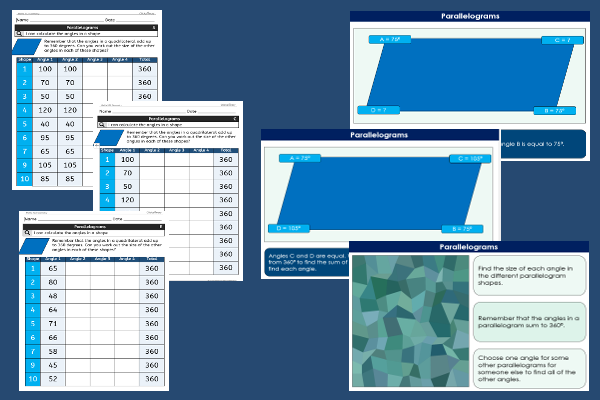Home > Key Stage Two > Maths > Geometry > Angles > Shape Angles
Parallelogram Angles

This maths teaching pack for Key Stage Two gets the children to identify, classify and calculate the size of each of the four angles that can be found in different example parallelogram shapes.
The class can model and record how to use number calculations to find the values of the angles in each parallelogram to match the sum of three hundred and sixty degrees.
Download this teaching pack including classroom activities and an interactive presentation to identify, classify and calculate the size of each of the four angles that can be found in different example parallelogram shapes
Activities in this teaching pack include a set of differentiated worksheets to select and calculate the size of each of the four angles that can be found in different parallelogram shape using protractors and calculations to check that the angles in each parallelogram sum to three hundred and sixty degrees.
The interactive presentation gets the children to explore how to calculate the size of each of the angles found in different parallelogram shapes.
This lesson is part of a maths scheme of work to get the children to identify, record and classify some of the different types of angles that form the individual properties of a range of 2D shapes. There are teaching activities for shared learning, differentiated worksheets to support independent learning and interactive presentations to introduce concepts and key skills.
-

Space Race
Explore how the space race in the 1950s and 1960s heralded a number of technological, cultural and political changes and advancements in the world
-

Moses
Explore and record the life and achievements of Moses from the Old Testament in the Christian Bible and his impact on the development of Christianity
-

Theme Park Visit
Practise identifying and calculating the timing and duration of rides and events when visiting a theme park on a special family trip
-

Number Thousands
Compare, order and sequence different sets of four digits numbers by using the place value of their numerical digits including counting in steps of thousands
